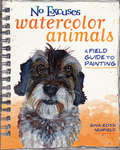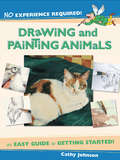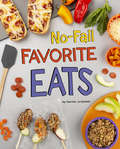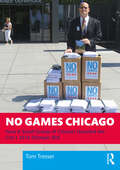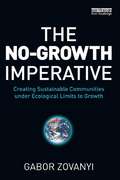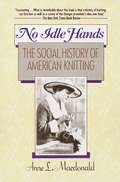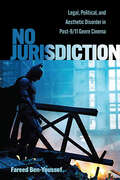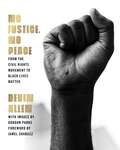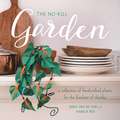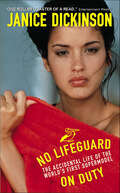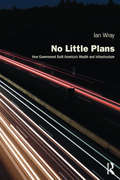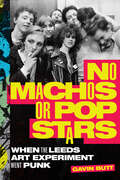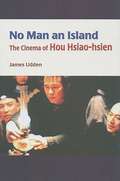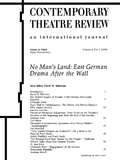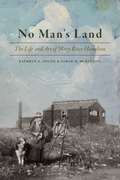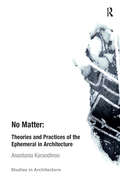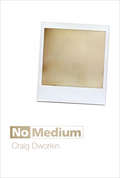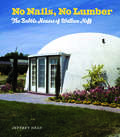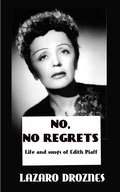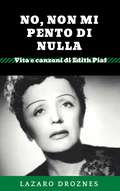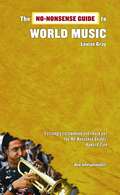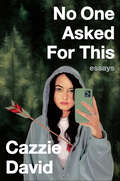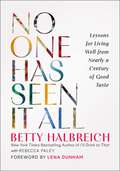- Table View
- List View
No Excuses Watercolor Animals: A Field Guide to Painting
by Gina Rossi ArmfieldExperience the freedom of watercolor painting and let go of fear! You'll have no excuse not to paint when you follow Gina Rossi Armfield as she shares her intuitive and inspirational approach to sketching and painting animals. Watercolor is the perfect medium for capturing the flowing textures, patterns and playful personalities of your favorite furry, feathered and farmyard friends. And it's fun using organic, sketchbook-style techniques to create soulful animal portraits. No intimidating exercises--just colorful and expressive works of art! The animal field guide is divided into 3 sections--Paws, Claws and Hooves--with 15 different animal projects that each include a photo reference, color palette and sketch template. Inside you'll find:Tricks for painting fur, feathers, beaks, claws, hooves and eyesEssential and easy paintbrush and watercolor instructionGuidance for working from photo referenceCreative background and text overlay ideas
No Experience Required - Drawing & Painting Animals (No Experience Required)
by Cathy JohnsonThis new book in the bestselling No Experience Required series includes 6 step-by-step demonstrations and 10 exercises to show you how to depict a variety of animals in a full range of mediums. Perfect for beginners, the exercises in this easy-to-follow guide are designed to yield immediate improvement in your work. You'll learn to use the most popular mediums including watercolor, pen and ink, pencil, and colored pencil to create a range of appealing animal subjects including cats, dogs, wild birds, horses and farm animals.
No-Fail Favorite Eats (Easy Eats)
by Katrina JorgensenCraving classic comfort food? No-Fail Favorite Eats has all the foods kid love to eat but don't know how to make. These recipes are simple, delicious, and kid-friendly.
No Games Chicago: How A Small Group of Citizens Derailed the City’s 2016 Olympic Bid
by Tom TresserPromoted as a prestigious economic opportunity and often aggressively sought by local leaders, hosting a modern Olympics can in fact be a “city-killer” that racks up billions of dollars in over-budget expenses, degrades the environment, and shreds civil liberties. This book recounts the successful efforts of grassroots organization No Games Chicago to derail Chicago's bid for the 2016 Summer Olympics in an entertaining case study of local activism with international reach. The group’s detailed strategies and tactics provide a much-needed playbook for scholars, journalists, and activists seeking people-powered alternatives to megaprojects and other tourism-centric economic development schemes.In a time when vital public services are being cut and curtailed, public spaces diminished, and civil liberties threatened by the over-policing of protests, America continues to dedicate billions of public dollars to private development and sports facilities. The activists of No Games Chicago broke new ground in their fight to represent the voice of the people among established local political powers in the decision-making process for Chicago’s Olympic bid. Their story resonates both nationally and globally – over 15 cities around the world have said “No Thank You!” to the Olympics since the success of No Games Chicago.Relevant to students and chroniclers of deliberative democracy, public policy, media for social change, community organizing, and the economics of sport, No Games Chicago is an enjoyable, practical addition to the literature of citizen governance, urban planning, and economic development.
The No-Growth Imperative: Creating Sustainable Communities under Ecological Limits to Growth
by Gabor ZovanyiMore than two decades of mounting evidence confirms that the existing scale of the human enterprise has surpassed global ecological limits to growth. Based on such limits, The No-Growth Imperative discounts current efforts to maintain growth through eco-efficiency initiatives and smart-growth programs, and argues that growth is inherently unsustainable and that the true nature of the challenge confronting us now is one of replacing the current growth imperative with a no-growth imperative. Gabor Zovanyi asserts that anything less than stopping growth would merely slow today’s dramatic degradation and destruction of ecosystems and their critical life-support services. Zovanyi makes the case that local communities must take action to stop their unsustainable demographic, economic, and urban increases, as an essential prerequisite to the realization of sustainable states. The book presents rationales and legally defensible strategies for stopping growth in local jurisdictions, and portrays the viability of no-growth communities by outlining their likely economic, social, political, and physical features. It will serve as a resource for those interested in shifting the focus of planning from growth accommodation to the creation of stable, sustainable communities. While conceding the challenges associated with transforming communities into no-growth entities, Zovanyi concludes by presenting evidence that suggests that prospects for realizing states of no growth are greater than might be assumed.
No Idle Hands: The Social History of American Knitting
by Anne MacdonaldExamines the history of the nation from the perspective of women and knitting, tracing the changes in day-to-day life and in women's roles in society from colonial times to the present.
No Jurisdiction: Legal, Political, and Aesthetic Disorder in Post-9/11 Genre Cinema (SUNY series, Horizons of Cinema)
by Fareed Ben-YoussefNo Jurisdiction interweaves autobiography and analysis to explore how a disabled American of French-Arab descent justifies his love for the (super)heroes who destroy brown people like himself. Framing Hollywood genre films as a key to understanding a crisis-filled world shaped by the global War on Terror, Fareed Ben-Youssef shows how, in response to 9/11, filmmakers and lawmakers mobilized iconic characters—the cowboy, the femme fatale, and the superhero—to make sense of our traumas and inspire new legal landscapes. The competing visions of power produced in this dialogue between Hollywood entertainment and mainstream politics underscore genre cinema's multivalent purpose: to normalize state violence and also to critique it.Chapters devoted to the Western, film noir, superhero movies, and global films that deploy and comment on these genres offer compelling readings of films ranging from the more apparent (The Dark Knight, Sicario, and Logan) to the more unexpected (Sin City, Adieu Gary, The Broken Circle Breakdown, and Tokyo Sonata). Through narratives of states of emergency that include vaguely defined enemies, obscured battlefield boundaries, and blurred lines between victims and perpetrators, a new post-9/11 film canon emerges. No Jurisdiction is a deeply personal work of film scholarship, arguing that we can face our complicity and discover opportunities for resistance through our beloved genre movies.
No Justice, No Peace: From the Civil Rights Movement to Black Lives Matter
by Devin AllenNautilus Book Awards' Better Books for a Better WorldA Movement in Words and Images Award-winning photographer Devin Allen has devoted the last six years to documenting the protests of the Black Lives Matter movement, from its early days in Baltimore, Maryland, up to the present day. The riveting images in No Justice, No Peace provide a lens on the resistance that has empowered Black lives generation after generation. Allen&’s signature black-and-white photos bear witness to the profound history of African Americans and allies in the fight for social justice and portray the collective action over decades in stunning, timeless portraits. Allen&’s remarkable photos of today&’s Black Lives Matter protests, which have been featured in the New York Times, the Washington Post, and twice on the cover of Time magazine, were inspired by Gordon Parks of the Civil Rights Movement, and create a vision of the past and future of Black activism and leadership in America. With contributions from twenty-six bestselling and influential writers and activists of today such as Clint Smith, DeRay Mckesson, D. Watkins, Jacqueline Woodson, Emmanuel Acho, Keeanga-Yamahtta Taylor, and more, alongside the words of past writers and activists such as Martin Luther King Jr, Frederick Douglass, Malcolm X, Maya Angelou, and John Lewis, No Justice, No Peace is a reminder of the moral responsibility of Americans to break unjust laws and take direct action. In words and pictures, No Justice, No Peace honors the connection between activism today and that of the past. If indeed hindsight is 20/20, this artistic look back is a lens on history that enlarges our understanding of the lasting predicament of racism in the United States of America. At once deeply intimate and profoundly uplifting, No Justice, No Peace is a visual tribute to Black resistance and a stern missive on the tough, but necessary, road that lies ahead.
The No-Kill Garden: A Collection of Handcrafted Plants for the Blackest of Thumbs
by Nikki Van De Car Angela RioCraft lush, beautiful plants--from succulents and ferns to blooming flowers--with The No Kill Garden, a collection of more than 30 paper, felt, knit, and crocheted projects that bring the outdoors in.Many of us love plants . . . but it often feels like plants don't love us back. For those people -- the people who have purchased several "impossible to kill" houseplants, only to find them dead mere weeks later -- there is The No Kill Garden, a charming collection of plants to craft and share.The handcrafted plants offered in this beguiling volume provide the sense of being surrounded by green, luscious plant life, without having to worry about that pesky watering. The No Kill Garden offers a wide variety of plants, from mushrooms and flowers to vines and terrariums, and a broad range of easy-to-follow crafts, including paper, felt, needle-felt, knit, and crochet. The more than 30 projects in this book are not just random flowers or leaves, either -- each of the crafted plants is inspired by a specific variety and is accompanied by a lively description of its main characters. Each of the plants is structured for a beginner, so that anyone with an interest in crafting can make them, and is paired with beautiful images of the finished project to delight and inspire readers.
No Lifeguard on Duty: The Accidental Life of the World's First Supermodel
by Janice Dickinson“Supermodel Dickinson's sex- and booze-soaked autobiography brings readers on a roller-coaster ride through the world of modeling” (Publishers Weekly).The life of Janice Dickinson is a story of extremes: uncontrolled energy, mad self-confidence and crushing insecurity, a boundless appetite for life and a ceaseless drive to self-destruct. During the 1970s she was the first lush-lipped, long-stemmed, dark-eyed brunette to break through and become not just a model but a supermodel—a term she coined for herself.She graced magazine covers from Vogue to Elle to Cosmopolitan, in photographs by Avedon and Irving Penn and fashions by Versace and Calvin Klein. She was voracious in everything: passionate affairs, endless partying, and a drug habit that dogged her through twenty years and three husbands. She spent her glory days with Gia Carangi and Christie Brinkley and her nights with Warren Beatty, Jack Nicholson, and Sylvester Stallone.Yet Dickinson’s life is no mere diva cartoon. Throughout her life she is haunted by the violent abuse she suffered at her father’s hands—a story she tells here for the first time. And as she careens from runway to rehab to rock bottom to recovery, readers will be captivated by her tale of survival.
No Little Plans: How Government Built America’s Wealth and Infrastructure (Planning, History and Environment Series)
by Ian WrayIs planning for America anathema to the pursuit of life, liberty and happiness? Is it true, as ideologues like Friedrich Von Hayek, Milton Friedman, and Ayn Rand have claimed, that planning leads to dictatorship, that the state is wholly destructive, and that prosperity is owed entirely to the workings of a free market? To answer these questions Ian Wray’s book goes in search of an America shaped by government, plans and bureaucrats, not by businesses, bankers and shareholders. He demonstrates that government plans did not damage American wealth. On the contrary, they built it, and in the most profound ways. In three parts, the book is an intellectual roller coaster. Part I takes the reader downhill, examining the rise and fall of rational planning, and looks at the converging bands of planning critics, led on the right by the Chicago School of Economics, on the left by the rise of conservation and the ‘counterculture’, and two brilliantly iconoclastic writers – Jane Jacobs and Rachel Carson. In Part II, eight case studies take us from the trans-continental railroads through the national parks, the Federal dams and hydropower schemes, the wartime arsenal of democracy, to the postwar interstate highways, planning for New York, the moon shot and the creation of the internet. These are stories of immense government achievement. Part III looks at what might lie ahead, reflecting on a huge irony: the ideology which underpins the economic and political rise of Asia (by which America now feels so threatened) echoes the pragmatic plans and actions which once secured America’s rise to globalism.
No Machos or Pop Stars: When the Leeds Art Experiment Went Punk
by Gavin ButtAfter punk’s arrival in 1976, many art students in the northern English city of Leeds traded their paintbrushes for guitars and synthesizers. In bands ranging from Gang of Four, Soft Cell, and Delta 5 to the Mekons, Scritti Politti, and Fad Gadget, these artists-turned-musicians challenged the limits of what was deemed possible in rock and pop music. Taking avant-garde ideas to the record-buying public, they created Situationist antirock and art punk, penned deconstructed pop ditties about Jacques Derrida, and took the aesthetics of collage and shock to dark, brooding electro-dance music. In No Machos or Pop Stars Gavin Butt tells the fascinating story of the post-punk scene in Leeds, showing how England’s state-funded education policy brought together art students from different social classes to create a fertile ground for musical experimentation. Drawing on extensive interviews with band members, their associates, and teachers, Butt details the groups who wanted to dismantle both art world and music industry hierarchies by making it possible to dance to their art. Their stories reveal the subversive influence of art school in a regional music scene of lasting international significance.
No Man an Island
by James UddenThis pioneering study of Hou Hsiao-hsien illuminates the many distinctive achievements of Taiwan's famous director. His body of work in films such as The Puppetmaster, City of Sadness, and Flowers of Shanghai reflects a powerfully unique style characterized by intricate lighting, improvisational acting, and exceptionally long, static shots. James Udden argues that Hou's films reflect Taiwan's peculiar historical and geographical situation and could only have emerged there. Udden also examines the regional impact Hou's films have had on other Asian directors and cinema artists.
No Man's Land
by David W. RobinsonThe political events of "annus mirabilis" 1989 marked a rare turning point in world history, but the significance of the year for German literary history is unique. As the 40-year-old German Democratic Republic ceased to exist, so too did the special circumstances which had fostered a literature separate from and in competition with that of the Federal Republic of Germany. A new period of literary history was delimited almost overnight: Germany Democratic Republic literature now was something to be examined as a whole, cultural movement. At the same time, the literary traditions of the German Democratic Republic have continued to influence the contemporary cultural scene, often in ways that are only gradually becoming clear.The essays, memoirs, and plays collected in this special issue of Contemporary Theatre Review represent an early attempt to assess and reassess one of the German Democratic Republic's richest cultural domains: its theatre. Contributors include David W. Robinson, C
No Man's Land: The Life and Art of Mary Riter Hamilton, 1868-1954
by Kathryn A. Young Sarah M. McKinnonWhat force of will and circumstance drove a woman from a comfortable life painting china tea services to one of hardship and loneliness in the battle zones of France and Belgium following the Great War? For western Canadian artist Mary Riter Hamilton (1868-1954), art was her life’s passion. Her tale is one of tragedy and adventure, from homestead beginnings, to genteel drawing rooms in Winnipeg, Victoria and Vancouver, to Berlin and Parisian art schools, to Vimy and Ypres, and finally to illness and poverty in old age. "No Man’s Land" is the first biographical study of Hamilton, whose work can be found in galleries and art museums throughout Canada. Young and McKinnon’s meticulous research in unpublished private collections brings to light new correspondence between Hamilton and her friends, revealing the importance of female networks to an artist’s well being. Her letters from abroad, in particular, bring a woman’s perspective into the immediate post-war period and give voice to trying conditions. Hamilton’s career is situated within the context of her peers Florence Carlyle, Emily Carr, and Sophie Pemberton with whom she shared a Canadian and European experience.
No Matter: Theories and Practices of the Ephemeral in Architecture (Ashgate Studies in Architecture)
by Anastasia KarandinouHow do digital media (mobile phones, GPS, iPods, portable computers, internet, virtual realities, etc.) affect the way we perceive, inhabit and design space? Why do architects traditionally design, draw and map the visual, as opposed to other types of sensations of space (the sound, the smell, the texture, etc.)? Architecture is not only about the solid, material elements of space; it is also about the invisible, immaterial, intangible elements of space. This book examines the design, representation and reception of the ephemeral in architecture. It discusses how architects map and examine the spatial qualities that these elements create and questions whether - and if so, how - they take them into account in the designing process. Karandinou argues that current interest in the ephemeral in contemporary culture and architecture is related to the evolution of digital media; and that it is related to the new ways of thinking about space and everyday situations that new media enables. With sound and video recording devices now being embedded in everyday gadgets and mobile phones, capturing sounds or ephemeral situations and events has become an everyday habit. New animation techniques allow designers to think about space through time, as they are able to design dynamic and responsive spaces, as well as static spaces explored by someone over time. Contemporary video games are no longer based on a simple visual input and a keyboard; they now involve other senses, movement, and the response of the whole body in space. This book therefore argues that the traditional binary opposition between the sensuous and the digital is currently being reversed. Subsequently, new media can also function as a new tool-to-think-with about space. Designers are now able to think through time, and design spaces accordingly. Time, temporality, ephemerality, become central issues in the designing process. The notion first claimed by Marshall McLuhan in the 1960s, that the emergence of new di
No Medium
by Craig DworkinClose readings of ostensibly “blank” works—from unprinted pages to silent music—that point to a new understanding of media.In No Medium, Craig Dworkin looks at works that are blank, erased, clear, or silent, writing critically and substantively about works for which there would seem to be not only nothing to see but nothing to say. Examined closely, these ostensibly contentless works of art, literature, and music point to a new understanding of media and the limits of the artistic object.Dworkin considers works predicated on blank sheets of paper, from a fictional collection of poems in Jean Cocteau's Orphée to the actual publication of a ream of typing paper as a book of poetry; he compares Robert Rauschenberg's Erased De Kooning Drawing to the artist Nick Thurston's erased copy of Maurice Blanchot's The Space of Literature (in which only Thurston's marginalia were visible); and he scrutinizes the sexual politics of photographic representation and the implications of obscured or obliterated subjects of photographs. Reexamining the famous case of John Cage's 4'33”, Dworkin links Cage's composition to Rauschenberg's White Paintings, Ken Friedman's Zen for Record (and Nam June Paik's Zen for Film), and other works, offering also a “guide to further listening” that surveys more than 100 scores and recordings of “silent” music.Dworkin argues that we should understand media not as blank, base things but as social events, and that there is no medium, understood in isolation, but only and always a plurality of media: interpretive activities taking place in socially inscribed space.
No Medium
by Craig DworkinIn No Medium, Craig Dworkin looks at works that are blank, erased,clear, or silent, writing critically and substantively about works for which there would seem to benot only nothing to see but nothing to say. Examined closely, these ostensibly contentless works ofart, literature, and music point to a new understanding of media and the limits of the artisticobject. Dworkin considers works predicated on blank sheets of paper, from a fictional collection ofpoems in Jean Cocteau's Orphée to the actual publication of a ream of typingpaper as a book of poetry; he compares Robert Rauschenberg's Erased De KooningDrawing to the artist Nick Thurston's erased copy of Maurice Blanchot's The Spaceof Literature (in which only Thurston's marginalia were visible); and he scrutinizes thesexual politics of photographic representation and the implications of obscured or obliteratedsubjects of photographs. Reexamining the famous case of John Cage's 4'33",Dworkin links Cage's composition to Rauschenberg's White Paintings, KenFriedman's Zen for Record (and Nam June Paik's Zen for Film),and other works, offering also a "guide to further listening" that surveys more than 100scores and recordings of "silent" music. Dworkin argues that we should understand medianot as blank, base things but as social events, and that there is no medium, understood inisolation, but only and always a plurality of media: interpretive activities taking place insocially inscribed space.
No More Nice Girls: Countercultural Essays
by Ellen WillisWith characteristic intelligence, wit, and feminist insight, Ellen Willis addresses democracy as she sees it: &“a commitment to individual freedom and egalitarian self-government in every area of social, economic, and cultural life.&” Moving between scholarly and down-to-earth activist writing styles, Willis confronts the conservative backlash that has slowly eroded democratic ideals and advances of the 1960s as well as the internal debates that have frequently splintered the left.
No Nails, No Lumber: The Bubble Houses of Wallace Neff
by Jeffrey HeadImagine a house constructed in less than forty-eight hours, without using lumber or nails, that is more resistant to fire, earthquakes, and hurricanes than any traditionally built structure. This may sound like the latest development in prefab housing or green architecture, but the design dates back to 1941 when architect Wallace Neff (1895–1982) developed Airform construction as a solution to the global housing crisis. Best known for his elegant Spanish Colonial–revival estates in Southern California, Neff had a private passion for his dome-shaped "bubble houses" made of reinforced concrete cast in position over an inflatable balloon. No Nails, No Lumber shows the beauty and versatility of Neff's design in new and vintage photography, previously unpublished illustrations, and archival material and ephemera.
No, no regrets
by Lázaro Droznes Rafael C. Osorio Mtz.Edith Piaf is one of the more lasting myths of the French and world music. Born literally in the street, she developed a carree as singer and composer that took her to be a world figure of excepcional relevance. This show is a recreation of the historic recitals of the Olympia intercut with stories and anecdotes of her life that reflect her deep love for the music, for the live and for the men. She lived her life always on the limits, defying everything and risking everything. She lived as she sang: forcing her little body to the extreme of her posibilities. And she didn’t regret
No, Non Mi Pento di Nulla: Vita e canzoni di Edith Piaf
by Lazaro DroznesEdith Piaf è uno dei miti più duraturi della musica francese e mondiale. Nata letteralmente per strada, ha sviluppato una carriera come cantante e compositrice che l'ha portata ad essere una figura mondiale di eccezionale rilevanza. Questo spettacolo è una ricreazione dei recitali storici di Olimpia intervallati da storie e aneddoti della sua vita che riflettono il suo profondo amore per la musica, per la vita e per gli uomini. Ha vissuto la sua vita sempre nei limiti, sfidando tutto e rischiando tutto. Ha vissuto mentre cantava: costringendo il suo piccolo corpo all'estremo delle sue possibilità. E lei non si pente di nulla.
The No-Nonsense Guide to World Music
by Louise Gray"World music" is an awkward phrase. Used to describe the hugely multifaceted nature of a range of typically non-English-language popular music from the world over, it's a tag that throws up as many problems as it does solutions.Louise Gray's The No-Nonsense Guide to World Music attempts to go behind the phrase to explore the reasons for the contemporary interest in world music, who listens to it, and why. Through chapters that focus on specific areas of music, such as rembetika, fado, trance music, and new folk, Gray explores the genres that have emerged from marginalized communities, music in conflict zones, and music as escapism.In this unique guide, which combines the seduction of sound with politics and social issues, the author makes the case for music as a powerful tool able to bring individuals together.Louise Gray is a writer and editor whose work on music and performing arts has appeared in the New Internationalist, The Wire, The Independent on Sunday, the Guardian, and Art Review. She co-edited Sound and the City (British Council, 2007), a book exploring the changing soundworld of China.
No One Asked For This: Essays
by Cazzie DavidA NEW YORK TIMES BESTSELLER. From writer/director Cazzie David comes a series of acerbic, darkly funny essays about anxiety, social media, misanthropy, and growing up in a wildly eccentric family.For Cazzie David, the world is one big trap door leading to death and despair and social phobia. From shame spirals caused by hookups to panic attacks about being alive and everyone else having to be alive too, David chronicles her life’s most chaotic moments with wit, bleak humor, and a mega-dose of self-awareness. In No One Asked for This, David provides readers with a singular but ultimately relatable tour through her mind, as she explores existential anxiety, family dynamics, and the utterly modern dilemma of having your breakup displayed on the Internet. With pitch-black humor resonant of her father, comedy legend Larry David, and topics that speak uniquely to generational malaise, No One Asked for This is the perfect companion for when you don’t really want a companion."Blisteringly honest...kind of like if a David Sedaris book was written by an anxiety-ridden millennial who grew up in Hollywood."—Entertainment Weekly "Cazzie David is the delicious antidote to the poison of basic influencer culture. This book will make all misanthropes feel seen and loved—well, seen and tolerated."—Diablo Cody, screenwriter and author of Candy Girl
No One Has Seen It All: Lessons for Living Well from Nearly a Century of Good Taste
by Betty HalbreichFrom the New York City legend, bestselling author, and iconic stylist Betty Halbreich comes this wise and witty collection of guidance from her 96 years to help people of all ages look, feel, and live their best. For half a century, Betty Halbreich curated wardrobes and bore witness to the vicissitudes of life as Bergdorf Goodman&’s original personal shopper. Of course, visitors to the store were awed by a 96-year-old woman who still held down a nine-to-five, let alone one in the youth-obsessed industry of fashion. But age is only half the story: Betty built that career by giving encouraging yet deeply honest advice. Much of it was about what to wear, but her insight was by no means relegated only to matters of the closet. She was known for her good taste on many levels, from her immaculate Park Avenue apartment of 70-plus years to the fashion stars she helped discover and the looks she styled for iconic series like Sex and the City and Gossip Girl. In short, Betty was in the unique position to dispense useful prescriptions on how to look good and live well at any age. This collection of her writings from the last five years of her life contains her signature firm and frank guidance on relationships, careers, style, etiquette, and keeping house, as well as eloquent reflections on aging, solitude, and modern life. The result is a definitive dispatch from a powerful woman who always held her head up high, inspiring you to do the same.
